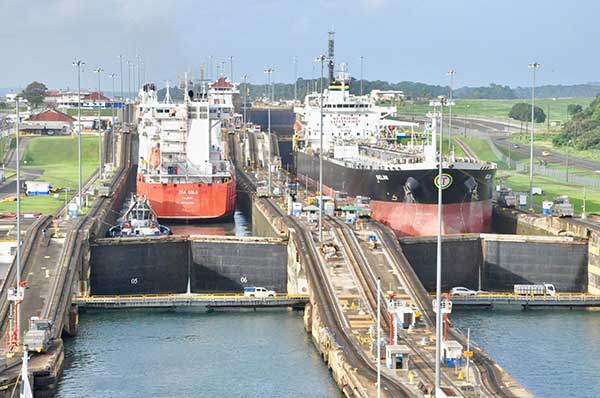Volume 26 | Issue 1
By Bart De Muynck, Chief Industry Officer, project44
Click here to read the complete illustrated article or continue below to read the text article.
The Panama Canal, an essential artery of global trade connecting the Atlantic and Pacific Oceans, is currently grappling with a severe drought. Water levels continue to decrease, raising concerns about the potential impact on supply chains and peak season shipping. Rainfall was less than 50% of normal from February to April near the canal and the lakes that feed it, according to ACP (Autoridad del Canal de Panamá). Water levels in the larger of the two lakes that feed the canal, Lake Gatun, are projected to hit historic lows in July.
This drought has led to restrictions in ships’ drafts from the canal’s normal operating drafts at 50 feet – limiting how much cargo ships can carry. On May 24, Neo-Panamax vessels, the largest ships that transit the waterway, were limited to drafts of up to 44.5 feet, down from an already restricted 45 feet. The draft limit was reduced again to 44 feet on May 30. The impacts of the reduction of 6 feet are set to reduce space for most shippers on Neo-Panamax vessels by 40%. Among the Neo-Panamax users of the Panama Canal in April, container vessels made up 45% of traffic, followed by carriers of liquefied petroleum gas, dry bulk and liquefied natural gas.

The Panama Canal drought could disrupt the usual shipping routes that manufacturers rely on. With decreasing water levels, larger vessels may experience draft restrictions, limiting their passage through the canal. This disruption forces shippers to seek alternative routes, such as circumnavigating South America’s Cape Horn or opting for longer trans-Pacific or trans-Atlantic routes. These detours can result in longer transit times, increased fuel costs and potential congestion at alternate ports, impacting supply chain efficiency and timely delivery. This news is concerning as we had seen larger volumes of ships going through the Panama Canal to divert to the Gulf Coast and East Coast ports. Recent terminal closures at major West Coast ports due to ongoing labor disputes have caused delays and unpredictability in West Coast operations. Now shippers are forced to choose between uncertain labor conditions, lower amounts of volume or longer trade routes.
The Panama Canal’s historic low water level projected for July coincides with peak season shipping, when manufacturers experience high demand for their products. Traditionally, this period sees a surge in maritime trade as companies prepare for major retail events, such as the holiday season. The water level constraints at the canal can exacerbate the strain on supply chains, as shipping capacity becomes limited. This scarcity of available routes and increased competition for limited slots can lead to higher freight rates and challenges in meeting peak season demands. The drought-induced disruptions in the Panama Canal can further result in supply chain delays and inventory management challenges. Businesses that depend on just-in-time (JIT) or lean inventory strategies may encounter difficulties in maintaining optimal stock levels.
Longer transit times, port congestion and unpredictable scheduling can disrupt the seamless flow of goods, potentially leading to stockouts, production bottlenecks and customer dissatisfaction. To mitigate the impact of these delays, businesses must prioritize effective inventory management, contingency planning and close collaboration with suppliers.
Limited canal availability may lead to higher freight rates as carriers seek to optimize their operations and cover the additional expenses associated with longer routes or port congestion. Businesses reliant on the canal for cost-effective transportation may face financial pressure as they grapple with increased shipping expenses. Consumers can expect that these increased expenses will eventually result in higher prices for goods, possibly further increasing inflation and hurting consumer demand in an already weakened economy.
The Panama Canal drought highlights the importance of building resilient supply chains and implementing robust risk management strategies. Manufacturers should conduct scenario planning where shippers can map alternative shipping routes, establish backup suppliers and invest in technologies that enhance supply chain visibility and agility. By proactively managing risks and anticipating potential disruptions, businesses can mitigate the impact on their supply chains and maintain operational continuity.
The Panama Canal drought presents significant challenges for supply chains and peak season shipping, including disrupted shipping routes, inventory management issues, rising costs and the need for diversification. It is expected that the situation will only be exacerbated by El Niño heading into 2024 – so it is imperative manufacturers figure out their risk management strategies as soon as possible.

Bart De Muynck is Chief Industry Officer at project44 where he drives supply chain industry thought leadership and supports customers with their strategies. A logistics industry thought leader with 30 years of experience, Bart previously served as VP of Research at Gartner. Earlier in his career, Bart held logistics roles with PepsiCo, Elemica, Penske Logistics, GE Capital, and EY.
In this episode, I sat down with Beejan Giga, Director | Partner and Caleb Emerson, Senior Results Manager at Carpedia International. We discussed the insights behind their recent Industry Today article, “Thinking Three Moves Ahead” and together we explored how manufacturers can plan more strategically, align with their suppliers, and build the operational discipline needed to support intentional, sustainable growth. It was a conversation packed with practical perspectives on navigating a fast-changing industry landscape.